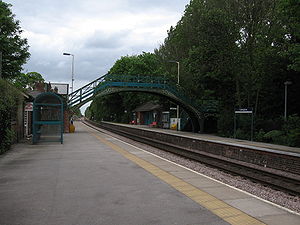- Cottingham railway station
-
Cottingham 
Location Place Cottingham Local authority East Riding of Yorkshire Coordinates 53°46′54″N 0°24′18″W / 53.781734°N 0.405000°WCoordinates: 53°46′54″N 0°24′18″W / 53.781734°N 0.405000°W Grid reference TA051328 Operations Station code CGM Managed by Northern Rail Number of platforms 2 Live arrivals/departures and station information
from National Rail EnquiriesAnnual rail passenger usage 2005/06 * 0.214 million 2006/07 * 0.209 million 2007/08 * 0.199 million 2008/09 * 0.201 million 2009/10 * 0.199 million History Opened 6 October 1846 National Rail - UK railway stations A B C D E F G H I J K L M N O P Q R S T U V W X Y Z * Annual passenger usage based on sales of tickets in stated financial year(s) which end or originate at Cottingham from Office of Rail Regulation statistics. Please note: methodology may vary year on year. Cottingham railway station serves the village of Cottingham in the East Riding of Yorkshire, England. It is located on the Yorkshire Coast Line and is operated by Northern Rail who provide all passenger train services.
The station serves the northern suburbs of Hull and generates much commuter traffic.
Contents
History
See also: Hull and Bridlington RailwayThe station was opened (along with the rest of the line from the original Hull and Selby Railway station at Manor House Street[where?]) on 6 October 1846.[1]
The station building was designed by G.T. Andrews,[2] consisting of two platforms, a stationmaster's house, and waiting rooms. In addition to the passenger facilities there was a goods shed, and coal depot to the west of the line, reached by points to the north of the station.[3] Goods transit into Cottingham included coal and building materials, whilst goods outwards from cottingham included large amounts of agricultural produce as well as livestock. Goods traffic ended in 1970.[4]
Halfway between Cottingham and Hull, a junction was created when a direct line was opened to the new York and North Midland Railway terminus at Hull in 1848.[5] The original line south of Cottingham (later known as the Newington branch) was subsequently utilised as a direct route towards Brough and points west, bypassing the busy station at Paragon for through trains to and from the coast, and was particularly busy in the summer months but was closed to all traffic in May 1965[6] to allow the removal of several inconvenient level crossings along its route, leaving the 1848 line to handle all remaining services.
In 1988, the stationmaster's house, the station itself and the former goods shed were listed as a Grade II listed buildings.[7][8][9] The footbridge on the station platform is of a standard NER cast iron pre-assembled design.
Services
All services on the Hull to Bridlington and Scarborough line call here, giving the station a basic half-hourly service in each direction with several additional peak hour trains to and from Beverley. There is an hourly service each way on Sundays throughout the year since the December 2009 timetable change (see GB National Rail Timetable 43), with six trains in each direction through to/from Scarborough.
References
- ^ Body p. 91
- ^ Last of the Cottingham Essays, A.H. Stamp, pp. 15-16
- ^ Last of the Cottingham Essays , A.H. Stamp , p. 82
- ^ Last of the Cottingham Essays, A.H. Stamp, pp. 43, 50, 76-77, 95, 107
- ^ Hunt, p. 56
- ^ Hunt, p. 58
- ^ Goods Shed At Cottingham Station www.imagesofengland.org.uk
- ^ Railway Station, Station Road www.imagesofengland.org.uk
- ^ Station-Master's House, Station Road, Cottingham www.imagesofengland.org.uk
Sources
- Body, G. (1988), PSL Field Guides - Railways of the Eastern Region Volume 2, Patrick Stephens Ltd, Wellingborough, ISBN 1-85260-072-1
- Hunt, J (2009), To Hull and Back, RAIL Magazine article, Issue 617, May 2009
- The Last of the Cottingham Essays , A.H. Stamp , Cottingham Local History Society , 1993 , "Cottingham's Railway Line" pp. 15–115
External links
- Train times and station information for Cottingham railway station from National Rail
Preceding station  National Rail
National RailFollowing station Hull ParagonNorthern Rail Categories:- Railway stations in the East Riding of Yorkshire
- Former North Eastern Railway (UK) stations
- Railway stations opened in 1846
- Railway stations served by Northern Rail
- DfT Category F1 stations
- Grade II listed buildings in the East Riding of Yorkshire
Wikimedia Foundation. 2010.

